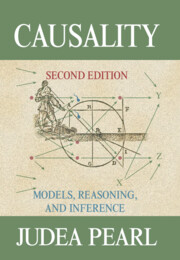Book contents
- Frontmatter
- Dedication
- Contents
- Preface to the First Edition
- Preface to the Second Edition
- 1 Introduction to Probabilities, Graphs, and Causal Models
- 2 A Theory of Inferred Causation
- 3 Causal Diagrams and the Identification of Causal Effects
- 4 Actions, Plans, and Direct Effects
- 5 Causality and Structural Models in Social Science and Economics
- 6 Simpson’s Paradox, Confounding, and Collapsibility
- 7 The Logic of Structure-Based Counterfactuals
- 8 Imperfect Experiments: Bounding Effects and Counterfactuals
- 9 Probability of Causation: Interpretation and Identification
- 10 The Actual Cause
- 11 Reflections, Elaborations, and Discussions with Readers
- Epilogue The Art and Science of Cause and Effect
- Bibliography
- Name Index
- Subject Index
Preface to the Second Edition
Published online by Cambridge University Press: 05 March 2013
- Frontmatter
- Dedication
- Contents
- Preface to the First Edition
- Preface to the Second Edition
- 1 Introduction to Probabilities, Graphs, and Causal Models
- 2 A Theory of Inferred Causation
- 3 Causal Diagrams and the Identification of Causal Effects
- 4 Actions, Plans, and Direct Effects
- 5 Causality and Structural Models in Social Science and Economics
- 6 Simpson’s Paradox, Confounding, and Collapsibility
- 7 The Logic of Structure-Based Counterfactuals
- 8 Imperfect Experiments: Bounding Effects and Counterfactuals
- 9 Probability of Causation: Interpretation and Identification
- 10 The Actual Cause
- 11 Reflections, Elaborations, and Discussions with Readers
- Epilogue The Art and Science of Cause and Effect
- Bibliography
- Name Index
- Subject Index
Summary
It has been more than eight years since the first edition of this book presented readers with the friendly face of causation and her mathematical artistry. The popular reception of the book and the rapid expansion of the structural theory of causation call for a new edition to assist causation through her second transformation – from a demystified wonder to a commonplace tool in research and education. This edition (1) provides technical corrections, updates, and clarifications in all ten chapters of the original book, (2) adds summaries of new developments and annotated bibliographical references at the end of each chapter, and (3) elucidates subtle issues that readers and reviewers have found perplexing, objectionable, or in need of elaboration. These are assembled into an entirely new chapter (11) which, I sincerely hope, clears the province of causal thinking from the last traces of controversy.
Teachers who have taught from this book before should find the revised edition more lucid and palatable, while those who have waited for scouts to carve the path will find the road paved and tested. Supplementary educational material, slides, tutorials, and homework can be found on my website, http://www.cs.ucla.edu/∼judea/.
My main audience remain the students: students of statistics who wonder why instructors are reluctant to discuss causality in class; students of epidemiology who wonder why elementary concepts such as confounding are so hard to define mathematically; students of economics and social science who question the meaning of the parameters they estimate; and, naturally, students of artificial intelligence and cognitive science, who write programs and theories for knowledge discovery, causal explanations, and causal speech.
I hope that each of these groups will find the unified theory of causation presented in this book to be both inspirational and instrumental in tackling new challenges in their respective fields.
- Type
- Chapter
- Information
- CausalityModels, Reasoning, and Inference, pp. xix - xxPublisher: Cambridge University PressPrint publication year: 2009



